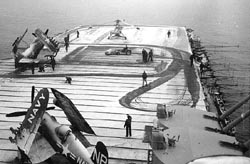Official
U.S. Navy Photograph

Snowly
flight deck of USS Valley Forge in Korean waters, 1951
U.S.S. FLOYD B. PARKS
PARKS is the flagship
of Commander Destroyer Squadron ONE and serves in the U.S.
Pacific Fleet under Commander Cruiser-Destroyer Force, Pacific
Fleet. Her principal duty is that of anti-submarine warfare,
although she is equipped to handle numerous details such
as anti-aircraft defense, surface and shore bombardment,
and surface attack with torpedoes.
THE KOREAN WAR
When the Korean War began on June 25. 1950, many V-12s
had finished college and had been working at their civilian
jobs for some time. Others were just finishing professional
school. A surprising number of V-12s had stayed on active duty
and eventually transferred to the regular Navy. Others. although
they were on inactive duty, had stayed in the active Naval Reserve,
meeting once a week at reserve units around the country.When
President Truman announced on June 27 that the United States
forces would come to the aid of the Republic of Korea (South
Korea), most of the reservists began to watch their mailboxes
with some concern. In September and October many of them received
orders to report to a specified naval station.
While this
history concerns the U. S. Navy, no record of the blockade
and bombardment effort in Korea can be made without recording
the valuable contributions of the combatant vessels of nine
other nations.The US Navy primarily worked with British and
Korean ships. Other nations included: Australia, Canada, Netherlands,
Colombia, New Zealand, France, Republic of Korea, and Thailand.Ships
of the naval forces of these nations served with credit and
effectiveness in the blockade and bombardment effort. TF 95's
missions in approximate order of priority to be these:
1.
Blockade Korea
2. Deliver gunfire support to UN troops on east coast
3. Bombard
4. Conduct anti-mining
5. Screen ship for aircraft carriers
6. Pick up downed pilots*
7. Conduct anti-submarine warfare
8. Control coastal fishing
8. Obtain intelligence.
*Primarily done by helicopters who delivered pilots to
ship
Accordingly,
on 29 January 1951, the carriers of Task Force 77 commenced
the interdiction of the east coast bridges. The bitter Korean
winter weather, with its low temperatures, snow, sleet, and
ice, became a major problem for both ships and aircraft.
It was
too cold to go on deck and not a winter wonderland. Ice,
snow and the cold of the Korean winter hampered naval operations.
next page
|
 "The
Fightin' Floyd B"
"The
Fightin' Floyd B"

